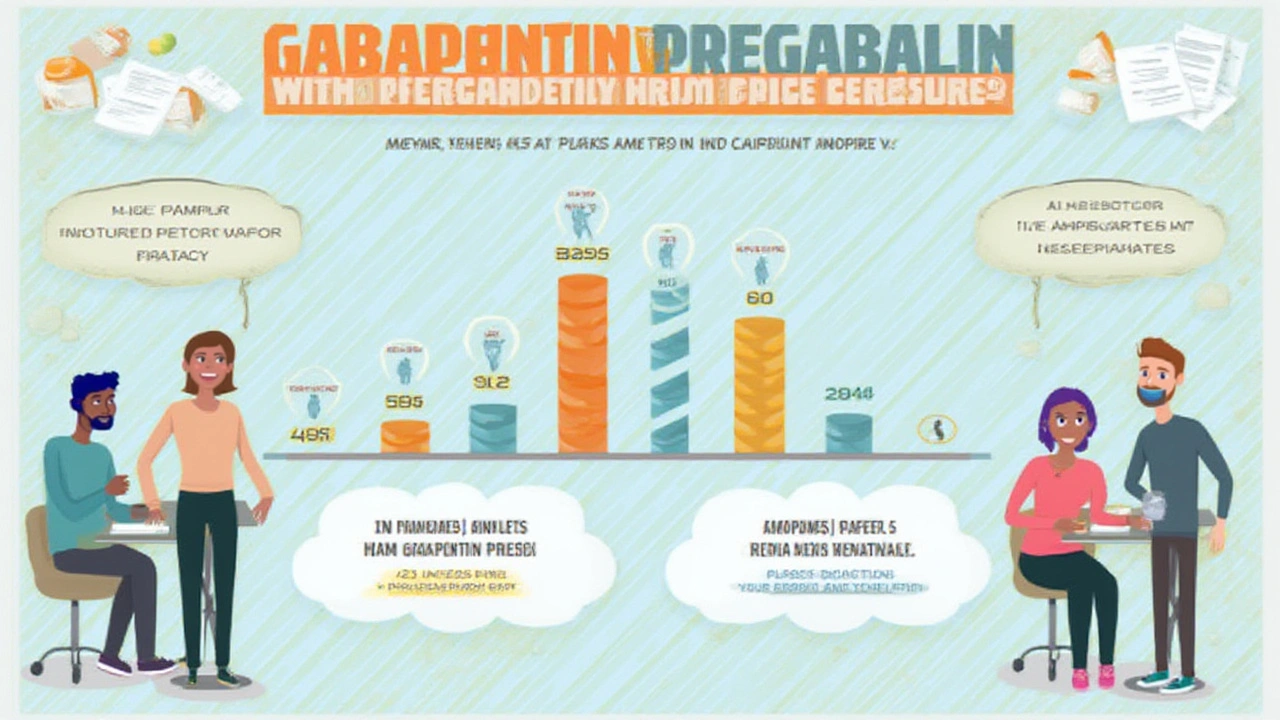Imagine needing relief for burning nerve pain, restless nights, or even constant tingling—and the pharmacy counter is the only thing standing between you and some comfort. Two of the biggest names folks hear tossed around are gabapentin and pregabalin. Both are cousins in the world of nerve pain drugs, but the differences between them could seriously impact your wallet, your insurance coverage, and—let’s be honest—the way you feel day to day.
Understanding Gabapentin and Pregabalin: The Nitty-Gritty
So, what are these meds exactly? Gabapentin (you might hear it called Neurontin) and pregabalin (that’s Lyrica to most people) are anti-seizure drugs that docs use for a ton of off-label stuff, especially nerve pain. They mess with calcium channels in your brain to quiet down hyperactive nerves.
Gabapentin got the FDA’s stamp way back in 1993. Pretty much every pharmacy in North America stocks generic versions, which helped drop prices after its patent expired. Pregabalin is a bit younger, emerging in 2004 and earning a reputation for working faster and sometimes hitting those stubborn nerve pains harder.
What really surprises a lot of people is how these two work on the body. Gabapentin takes longer to hit peak levels in your blood (up to 3 hours) and your body hustles it out quickly. Pregabalin? It’s absorbed more efficiently and acts quicker, but your kidneys do the heavy lifting to clear both drugs. If you’ve ever had kidney issues, dosing needs extra caution from your doc.
Neither drug actually plays with GABA (that’s the brain’s calming chemical), even though their names might suggest it. That trip-up causes tons of confusion, especially among new patients trying to research what the side effects or risks could be.
Cost Showdown: Wallet Impact and Generic Options
Let’s talk cash. For 90% of folks, this is really where the decision gets made. Gabapentin is the budget-friendly superstar. Because it’s off-patent and made by a parade of manufacturers, you can find it for a fraction of the price that pregabalin commands. Back in 2024, a month’s supply of generic gabapentin might set you back $10–$20 without insurance, especially if you nab a discount card or use a mail-order pharmacy.
Pregabalin used to be an expensive beast, with some people shelling out north of $400 a month before the generic finally hit US shelves. Now, it’s come down, but pregabalin is still usually 2x–10x pricier than gabapentin, depending on your pharmacy and whether you’ve got insurance with good drug benefits. The cost gap widens even more outside the US.
| Medication | Average Monthly Cash Price (US, 2024) | Generic Availability |
|---|---|---|
| Gabapentin | $10–$40 | Yes |
| Pregabalin | $40–$200 (as low as $25 in some countries) | Yes (since 2022 in US) |
Of course, insurance coverage changes the game. For example: People with Medicaid or Medicare Part D plans are more likely to see gabapentin in the lowest copay tier. Pregabalin can often land in a higher copay group, or—especially for brand Lyrica—require prior authorization. That’s insurance speak for “prove you need it, or get denied.”
If you’re stuck paying out-of-pocket, or can’t get pregabalin covered, it’s worth searching for online pharmacies or checking out resources that list medications similar to gabapentin in case your doctor’s open to alternatives.

Effectiveness in the Real World: Does One Work Better?
Here’s where things get tricky. Drug studies would love to claim one medication is a silver bullet, but reality is messier (and more interesting). Both gabapentin and pregabalin are heavy hitters for nerve pain from stuff like shingles, diabetic neuropathy, fibromyalgia, and even restless legs syndrome. But response can be wildly personal.
Pregabalin tends to act faster—sometimes within days, while gabapentin can take a week or longer to kick in at the right dose. Some head-to-head trials show pregabalin might give a slightly better response rate (about 40% for sharp pain reduction, compared to gabapentin’s 30–35%), but that comes at a price, literally and in side effects. And here’s the twist: For some people, gabapentin just works better, no explanation. Personal genetics and metabolism are a huge wild card.
Typical doses paint a clear picture: Gabapentin doses can get high—meds bottles might say three times a day, at 300–900mg per dose. Pregabalin is usually twice daily, with smaller milligram amounts (50–150mg). That less frequent dosing is a selling point for someone who forgets pills. Specialist pain clinics often start folks on gabapentin first, ramping up as needed, and save pregabalin as the backup if nerves aren’t responding well, or if side effects crop up.
One study out of the UK in 2022 followed patients with diabetic nerve pain: Pregabalin gave faster, stronger pain relief in about 15% more cases, but dry mouth, weight gain, and dizziness forced nearly as many to stop the drug entirely. Gabapentin’s main annoyances were sedation and an odd “zombie fog” that sometimes faded after a few weeks.
Neither medication works for everyone—and annoyingly, figuring that out usually means a rough week or two as you titrate up, then wait to see if it helps. Switching between them is common, and you definitely want a tapering plan if you’re swapping from one to the other. Abruptly stopping either one can trigger withdrawal (think: anxiety, sweating, even tremors).
Insurance Coverage and Hidden Headaches
Pharmacies know that insurance decisions create chaos for folks on nerve pain meds. You’d think insurance companies would just green-light whichever helps, but nope—formularies play favorites. Right now, gabapentin nearly always scores the green light thanks to its low price and long generic track record. Pregabalin’s spotty coverage means docs have to write letters, argue on the phone, or send extra paperwork just to get you the new prescription. Patients get caught in the crossfire, running out of meds or paying sky-high prices during the wait.
Don’t forget about quantity limits and step therapy. Some insurers make you prove that gabapentin didn’t work, or gave you bad side effects, before they’ll approve pregabalin. That’s called step therapy, and it drives people nuts. Mail-order pharmacies can sometimes work around these limits, but not always.
Navigating all this is easier with your pharmacy’s help. They usually know which plans are picky about pregabalin, and some will even handle the prior authorization calls for you. If your doc prescribes pregabalin, ask them to include detailed notes on your chart—details about previous gabapentin fails can seriously speed up the insurance process.
Want one tip that often flies under the radar? If you have trouble with coverage, check if the manufacturer offers a patient assistance program. Lyrica, for instance, has one. The catch: You can’t be on government insurance and must meet income cutoffs. But it’s worth a shot if you’re struggling.
Mental health and addiction concerns can pop up here too. In the last few years, both drugs made headlines after some states called them "controlled substances." Gabapentin abuse rates are rising—not nearly at opioid levels, but enough for tighter tracking in places like Kentucky and Ohio. Pregabalin is a Schedule V drug nationwide, so getting refills or extras is watched closely.








Charity Peters
July 12, 2025 AT 15:49Been on gabapentin for years for my neuropathy. Got it for $12 at Walmart with a coupon. Pregabalin? My insurance barely covers it. I don’t care if it’s ‘faster’-if I’m not screaming in pain, why spend extra?
Faye Woesthuis
July 14, 2025 AT 15:26If you’re still on gabapentin you’re either cheap or clueless. Pregabalin works. Period. Stop wasting your life on outdated junk.
raja gopal
July 14, 2025 AT 17:34As someone from India, I’ve seen both used widely here. Gabapentin is everywhere-cheap, accessible, and for many, enough. Pregabalin is like the luxury version. But I’ve met people who swear by gabapentin even after trying pregabalin. It’s not about the drug-it’s about your body. Be patient with the trial.
Samantha Stonebraker
July 14, 2025 AT 21:44There’s something sacred about finding what your nervous system tolerates. Not every pain needs a fancy solution. Gabapentin might feel like a foggy blanket, but sometimes that’s exactly what your overworked nerves need. Pregabalin? It’s the sleek sports car-faster, shinier, but burns more fuel and leaves you with a bigger bill. Neither is better. One just fits your rhythm better.
Kevin Mustelier
July 16, 2025 AT 09:20lol at people still using gabapentin like it’s 2008. 🤡 Pregabalin’s the real MVP. Also, if you’re not on a copay plan, you’re doing life wrong. 💸
Keith Avery
July 16, 2025 AT 23:29Let’s be real-this entire post is just a glorified pharmaceutical ad disguised as ‘real-world’ insight. Neither drug has robust long-term data. The fact that you’re comparing them at all shows how little we actually know about neuropathic pain. Also, ‘off-label use’ is just a fancy way of saying ‘we’re guessing.’
Luke Webster
July 18, 2025 AT 10:13I’ve lived in the U.S. and India, and the access difference is wild. In India, gabapentin is sold over the counter in some places. In the U.S., you need a PhD just to get a refill. But here’s the thing-both drugs saved lives. One just costs more. It’s not about which is superior-it’s about who gets to heal. That’s the real issue.
Natalie Sofer
July 18, 2025 AT 14:12my dr switched me to pregabalin after gabapentin gave me the zombie vibes… but then i gained 15 lbs and felt like a balloon. back to gabapentin now. it’s not perfect but i can at least remember my kid’s birthday. 🙃
Tiffany Fox
July 19, 2025 AT 21:31Just wanna say-your doc’s job isn’t just to prescribe. It’s to help you navigate this mess. Ask them to write a note for insurance. Call your pharmacy. You’ve got this.
Rohini Paul
July 20, 2025 AT 11:22My cousin in Delhi takes gabapentin for sciatica and pays $2 a month. I’m in the U.S. and pay $180 for pregabalin. Same pain. Different worlds. Why is healthcare so broken here?
Courtney Mintenko
July 21, 2025 AT 02:46Everyone’s so obsessed with cost and efficacy but no one talks about the emotional toll of being a drug guinea pig. You lose months. You lose trust. You lose yourself. And then the docs say ‘try another one.’ Like it’s a flavor of ice cream.
Sean Goss
July 21, 2025 AT 10:04The entire premise is flawed. Neither gabapentin nor pregabalin is a true neuropathic agent-they’re calcium channel modulators with off-target effects. The clinical trials are underpowered, the endpoints are subjective, and the ‘real-world efficacy’ data is largely anecdotal. This post is a placebo for the anxious middle class.
Khamaile Shakeer
July 23, 2025 AT 04:54Why does everyone act like pregabalin is some magic bullet?? 😒 Gabapentin works for 70% of people. Pregabalin? Only 10% better… and costs 10x more. 🤦♂️ Also, if you’re on either drug and still scrolling Reddit at 3am… maybe try sleep hygiene? 😴💊